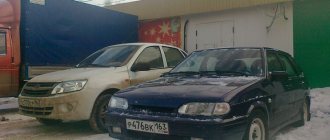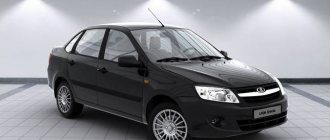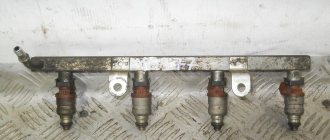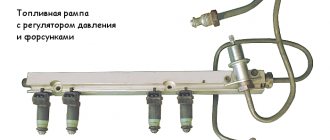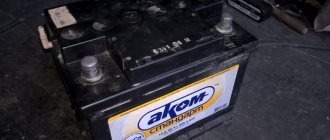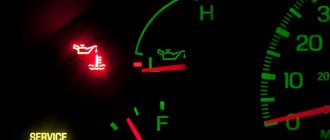05 December 2014 Lada.Online 123 101 8
An experienced driver knows how important it is to periodically check the pressure in your car's tires. If the pressure does not correspond to the recommended one, this leads to accelerated tire wear, as well as a deterioration in the stability and controllability of the vehicle. The table shows the recommended tire pressure for the Lada Granta.
What does air pressure in tires affect?
The pressure in car tires determines the level of driving comfort and safety, and also contributes to the durability of the working units and components of the car.
Low pressure in Lada Granta tires increases heating during rolling and contributes to wear of the tread tracks located along the edges. The integrity of the frame may even be compromised. Fuel consumption also increases. If you hit a pothole, the risk of damage to your rim or tire is much higher.
Tire pressure "Lada Grants"
Increased tire pressure on the Lada Granta overstrains the cord threads and wears out the middle section of the tread. In addition, when driving on a bad road, the shocks transmitted to the suspension and body will be more clearly felt by passengers. Of course, the suspension will also wear out more. And if you drive into a pit, the risk of a tire rupture increases.
Different pressure for all four wheels also has its drawback: in this situation, when braking, the car is guaranteed to be pulled to the side by the wheels with minimal pressure, and the car will actually start moving sideways.
Tire life
Reduced tire pressure on the Lada Granta increases tire abrasion at the edges.
Increased - also affects the service life of tires. In this case, the tension in the carcass threads increases: as a result, the cord breaks down noticeably faster. In this case, the tire interacts with the road through the middle section of the tread, which provokes its rapid wear.
Compliance with the recommended pressure allows you to evenly distribute the load and increase the tire life.
Machine controllability
The pressure of a specific value in the Lada Granta wheels is indicated for a reason. Although its reduced performance at low speeds does not particularly affect the car’s behavior, at speeds of 60 km/h or more, underinflated tires significantly worsen handling and increase braking distance.
A car with increased pressure in the tires on a dry road surface is somewhat better in handling, however, strong overinflation of the wheels leads to the fact that any sudden maneuver guarantees a skid (especially on a wet road), or even a complete loss of control.
With reduced pressure in the Granta wheels, the car’s ability to turn also changes. for example, a rear-wheel drive car with lowered front tires will have a harder time turning.
The inflation of the front wheels of a front-wheel drive car must always be normal, since its reduced level provokes skidding in an emergency situation.
P14 wheels on Grant
Patency
Even the owner of an ordinary four-wheel drive car, for example a sedan, can independently provide it with tolerable cross-country ability. To do this, just let some air out of the wheels, and they will not sag in sand, snow or mud. To even get out of a “black spot”, you just need to lower the pressure to 1.2 bar.
In a particularly difficult situation, if your wheels have a narrowed rim and a fairly wide tire (in this combination there is a lower risk of self-disassembly), the indicator can be increased to 1.0 bar.
Stability on slippery roads
A wet track always carries danger. But if you increase the pressure in the Lada Granta tires, reducing the contact patch of the rubber with the track, the risk of aquaplaning will also decrease. This will also improve handling and optimize fuel consumption. However, you need to know when to stop, as this option has its own disadvantage: an increased risk of a tire explosion.
If the car slips on wet grass, then, on the contrary, relieve the pressure.
Braking efficiency
The higher the pressure in the Grant R14 wheels, the less grip they have on the road. Consequently, the longer the braking distance: as the atmosphere decreases, it will decrease, but at the expense of reduced directional stability.
The best models for summer
Now let's present several worthy summer models:
Bridgestone Ecopia EP150
The tread of this Japanese tire is developed using a new technology (NANO-PROTECH), which makes it possible to reduce the coefficient of rotational resistance and, as a result, save fuel consumption. Plus, the EP150 turned out to be lighter in weight and almost silent.
Nitto NT860
Another Japanese tire produced in Malaysia. Very soft rubber, perfectly balanced and brakes, thanks to the deep tread, self-cleaning from dirt and snow. With all this, the best thing is the low price.
Kormoran Impulser B2
Serbian Kormoran was developed using Michelin technology. The tire is stable when driving at speed, does not “float” if it gets into a puddle, has excellent grip on the road and is controlled when cornering.
Matador MP 47 Hectorra
The new generation summer tire from Slovenia MP-47 Hectorra performs excellently on both dry and wet surfaces thanks to its asymmetrical pattern with four deep longitudinal grooves.
Tread elements are optimized to the maximum, which improves acceleration and braking efforts and reduces noise levels.
Which winter tires are best for a car, or what to put on it for the summer, is, of course, up to the owner to decide. It all depends on what climate zone you have to use the car and what roads you drive on. And our information is designed to understand the characteristics of certain models and the advisability of their use.
What should be the pressure in Grant tires under different conditions?
For every 10 degree change in temperature, the air pressure in the tire also changes by 0.1 bar. So, if in summer the indicator should be 1.9-2.0 atmospheres, then in winter or at full load it reaches 2.1-2.2, and cars with summer tires in April, they can only be pumped up occasionally until the beginning of September. But the winter one will have to be checked regularly after the next frost.
In summer
In the summer, during extreme heat, the pressure in the p14 wheels on the Grant increases slightly due to the heating of the air in the tires. So you don’t have to pump them up, plus or minus 0.3 atm.
in winter
In winter, the air is compressed, which is why the tires need to be pumped to the same 0.3 atmospheres: even if in a warm garage the pressure gauge shows the desired value, on the street the value will drop by at least 0.3 bar, and you will find yourself with underinflated tires.
Installing a pressure gauge to check tire pressure
For a relaxing ride
In Lada Granta wheels, the pressure should be standard for quiet driving, that is, recommended. Car manufacturers place the “cheat sheet” on the gas tank cap, the middle pillar or on the driver’s side door. As a rule, you can use tires of different sizes, and the required value for them is not always the same.
For racing
In motorsports, everything is determined by the contact patch of the tire. By increasing or decreasing it, it is easy to change the handling of the sports car.
By reducing the pressure in the wheels of the Lada Granta liftback, we increase the contact area. If you increase the pressure, the car then responds better to the steering impulse, and straight line acceleration increases due to reduced rolling resistance.
But the traction properties of the tire will also become less: overinflated wheels seem to stand on tiptoes. So, depending on the requirements of your type of motorsport, you need to find a compromise so that the tires have enough grip during acceleration and braking, but do not deform when cornering due to low inflation.
For long trips
When traveling long distances, it is recommended to lower the tire pressure by 0.1 atmospheres. Long driving easily compensates for this decrease by heating the air, which expands as a result.
For driving in mud
When you find yourself on a muddy dirt road, it is better to lower the wheels: the contact area will increase, the ride will become more comfortable, and the suspension will not wear out.
For driving in open mud, it is better to reduce the pressure to 1 bar. Just remember that in this case you should not accelerate over 30 km/h. Otherwise you risk losing control. It is also undesirable to let the tires go down too much before descending a steep slope, since during braking the tires will rotate independently even after the wheel rims are locked.
For driving on snow and ice
If ice catches you by surprise, it is better to lower your wheels to 1.5 atm. Tire wear will, of course, increase, but cross-country ability will also increase significantly. However, in this case, any high speed is unlikely, and overheating of the rubber at low temperatures most likely will not occur.
Forcing deep snow also means reducing pressure: this way you will noticeably increase the contact area, and, on the contrary, minimize the pressure on the snow.
The main thing is not to overdo it. To avoid getting stuck in the snow, it is recommended to inflate tires to 0.8–1 atm. But if you have low-profile ones, it is better not to drop below 1.2 atm.
"Lada Granta"
Please note that even a short trip on lowered wheels heats up the air in them and increases the pressure.
For transportation of goods
It is advisable to take into account the manufacturer's advice on tire pressure when fully loaded. At a minimum, you should inflate the wheels at least at the rear by 0.2–0.3 bar.
Tire pressure "Lada" in winter
In winter and summer, the pressure inside the tire changes due to environmental temperature changes. For example, in the summer, when it is very hot, the air inside the tire heats up and its volume increases. Therefore, the wheels need to be slightly underinflated, about 0.3 atmospheres. And in winter exactly the opposite happens. Due to low temperatures, the volume of air in a tire decreases, and therefore they should also be pumped at 0.3 atmospheres.
It is very important where exactly the car is located. If it is in a warm room, then when measuring pressure the pressure gauge will show optimal readings. But if you go outside in the cold, the tire performance will drop by about 0.4 Bar. And the car will already be driving on underinflated tires, and this is unsafe. Therefore, you should inflate the wheels in the garage and slightly increase the standard values, since they fall in the cold.
Fans of the Lada Kalina station wagon often do not think about changes in tire pressure at different times of the year. For such cars, the optimal indicators are 2.2 atmospheres on the wheels of the front axle, and 2.3 on the rear. Most drivers agree with these recommendations from the manufacturer and do not report severe discomfort while driving. But in winter, many people deviate from these standards. In cold weather, the front tires are inflated to 2.0 Bar, and the rear tires to 2.2 Bar. This takes into account that the tires on the car are factory. If the car is re-shod with wide-profile tires, the pressure readings increase. The front should be 2.4 Bar and the rear should be 2.5 Bar. Low-profile and narrow tires require 1.9-2.0 atmospheres on the front axle, and 2.0-2.2 on the rear.
The Lada Vesta sedan has a greater maximum load capacity than the previous model. The load capacity index is up to 615 kilograms. The instructions indicate pressure parameters equal to 2.1 atmospheres, both for the front and rear wheels. As the load increases, the rear wheels are pumped up to 2.2 bar. Such indicators are typical for tires R15 and R16. But in winter it is better to keep the pressure within 2.2 Bar. The manufacturer recommends measuring the amount of air in the tire at least once a week. And also such an event must be carried out before a long trip.
Fans of the Largus model should know that the atmospheric performance in this car is higher than in the previous models under consideration. The pressure in Largus wheels for tires R14 and R15 is 2.4 Bar on the front axle, and 2.6 on the rear. But owners of such cars note that with such parameters the car drives very hard, so they often underestimate the recommended readings. At the same time, there is no significant wear of the rubber. But you shouldn’t get carried away with underestimation, as this can lead to a lot of problems. If the driver is a fan of fast driving, then lowering the pressure by 1.0 Bar will be quite justified. The rubber heats up at high speed, and the volume of air increases, so such a decrease will not affect it.
How to determine tire pressure
Tires should be checked regularly: before a trip or once a week. Measure the pressure when the tires are cold, that is, several hours (4-5) after stopping the car. If pumping is required on the way, it is better to make it 10% more than normal. Verification can be carried out in different ways, which we will discuss further.
Compressor
A compressor is a special machine for inflating tires. Connect it to the mains and watch the built-in pressure gauge. When the pressure rises to the desired level, the device will simply turn off.
Pressure gauge
Using the pressure gauge is extremely simple:
- You need to remove the cap on a car tire.
- Apply the pressure gauge to the valve for a few seconds.
- Compare the performance of all four tires and, if necessary, inflate.
The entire procedure takes a maximum of a few minutes.
Sensors
The sensors convert the pressure information received from the wheel controllers into an electrical signal and transmit it to the transceiver via Bluetooth. A special program processes this data and, if necessary, signals the driver. Some systems send a message to a smartphone.
You can set the limit values of operating parameters yourself: adjustment is available from 1.7 to 3.2 bar.
Visually
It is better to carry out an inspection before each trip: at least just to see if there are any flat tires. But it is not possible to determine the pressure “by eye”: even 10 PSI and 20 PSI are practically indistinguishable in this way.
Handheld portable pressure gauge for checking tire pressure
Only a high-quality pressure gauge guarantees you an accurate result.
How to measure blood pressure correctly
There are only two methods here - either a car or a stationary pressure gauge is used to check (you can find it at a gas station or in a tire shop).
First of all, you need to make sure that the tire is “cold”, since you cannot reduce the pressure in “hot” tires. When the car moves, the rubber heats up, and, accordingly, the pressure increases - this also needs to be remembered.
Is it possible to drive on flat tires?
Driving with flat tires is, of course, possible, but it is fraught with consequences.
This results:
- to wipe the side protectors;
- excessive heating of rubber and its accelerated deterioration;
- deterioration of vehicle controllability, especially when cornering;
- excessively high fuel consumption.
The only advantages of underinflated tires are a soft ride, and also the fact that there is no noise or rattling. However, the disadvantages of such use clearly outweigh the advantages.
Is it possible to drive on overinflated tires?
Of course, you can ride with such tires, but if you do it too often, you cannot avoid the consequences:
- the suspension quickly fails;
- the middle section of the tread is wiped off;
- The interior rattles, and you can especially feel the bumps on the road.
The only plus is fuel economy.
How to pump up tires
You need to pump up the Lada Granta wheels according to the following scheme:
- Find out the recommended pressure.
- Check the level in the wheel.
- If the indicator is more than necessary, bleed off the excess: use a fingernail or something pointed to press the central pin of the nipple.
- If the indicator is less than required, then inflate the tire with a pump or compressor.
- Screw the nipple cap into place.
Tire pressure "Lada Grants": checking with a pressure gauge
Carry out this procedure for all tires.
Non-standard tire size for LADA Granta
On some cars it is possible to install wheels in the size range R16 or R17. But car owners should be aware that often such a change can only harm the car and worsen its overall quality indicators.
When releasing the Lada Granta, wheels with a diameter of R16 are used only on the Sport version, while the tire size is 195/50. In addition to this size, setting this diameter is possible at 175/50, 185/40, 195/40 and below.
For other Lada 2190 models, specialists and car manufacturers do not recommend installing disks whose diameter exceeds R15. Since it has been proven that the higher this indicator, the greater the risk of disc deformation. Therefore, when choosing new wheels and tires, you should not experiment with new sizes. Tires with dimensions that do not differ from the factory assembly are best suited for the car.

